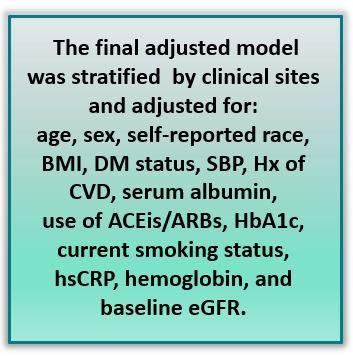Elevated Albuminuria, Even Within Normoalbuminuric Range, May Be Linked to Elevated Risk for CKD Progression, Renal Failure
New study findings raise important questions about how early to initiate therapy to reduce proteinuria and whether even lower levels should be sought to improve CKD outcomes.
Increasing levels of albuminuria in individuals with chronic kidney disease and albumin levels within the normal range (below 30 mg/g) may substantially elevate risk for progression of CKD and kidney failure, according to new research.
©alxmls/stock.adobe.com

The study, which enrolled participants who met criteria from the Chronic Renal Insufficiency Cohort (CRIC) study, found, specifically, that the 10-year absolute risk differences among participants with a urine albumin-creatinine ratio (UACR) of 15 mg/g or more compared with those who had UACRs of 5 to less than 15 mg/g and 0 to less than 5 mg/g were 7.9% and 10.7% higher for CKD progression and 5.1% and 6.3% higher for kidney failure, respectively.
The findings, published in the Annals of Internal Medicine, raise a number of questions the authors said, including when to initiate treatment for albuminuria in persons with CKD, whether reducing albumin levels further could improve disease outcomes, and whether albuminuria within the normoalbuminuric range, ie, less than 30 mg/g has prognostic value in persons with CKD.
“Few studies have evaluated the risk gradient for CKD progression in persons with CKD and albuminuria less than 30 mg/g,” Ashish Verma, MD, assistant professor of medicine at Boston University School of Medicine, and colleagues wrote. “Enhanced understanding of the risks associated with higher levels of albuminuria in the normoalbuminuric range may help change clinical thresholds to evaluate risk or to consider lowering albuminuria to levels less than 30 mg/g with newer kidney protective therapies in persons with CKD.”
“Enhanced understanding of the risks associated with higher levels of albuminuria in the normoalbuminuric range may help change clinical thresholds to evaluate risk or to consider lowering albuminuria to levels less than 30 mg/g with newer kidney protective therapies in persons with CKD.”
To explore further, Verma and colleagues tapped data for participants in the CRIC study, a multicenter, prospective, observational cohort study designed to study risk factors for cardiovascular disease (CVD), CKD progression, and death among individuals with mild to severe CKD. CRIC enrolled 3939 persons aged 21 to 74 years between June 2003 and September 2008 across 7 US sites.
Of the originally enrolled 3939 participants, 1629 met eligibility criteria for this study of CKD and UACR less than 30 mg/g. This final group had a mean age of 60.2 years, 52.2% were women and 54.3% identified as White.
The study’s primary exposure was baseline UACR, and the primary outcome of interest was CKD progression, defined as a composite of a 50% decline in eGFR, or incident kidney failure, defined as the initiation of dialysis or kidney transplantation, whichever came first. The secondary outcome was kidney failure. Researchers followed participants until the occurrence of death, withdrawal from the study, loss to follow-up, or January 30, 2018.1
The investigators evaluated UACR in 3 categories: 0 to less than 5 mg/g, 5 mg/g to less than 15 mg/g, and 15 mg/g and above, and calculated the 5- and 10-year adjusted cumulative incidences.
FINDINGS
Median baseline UACR were higher in participants who developed CKD progression (12.0 vs. 6.5 mg/g) and kidney failure (15.5 vs. 6.6 mg/g) compared with those who did not.
CKD progression
Verma and colleagues reported that over a median follow-up period of 9.8 years, 182 (11%) participants experienced CKD progression. The 10-year adjusted cumulative incidences of CKD progression according to UACR category were:
- 0 to <5 mg/g: 8.7% (95% CI, 5.9%-11.6%)
- 5 to <15 mg/g: 11.5% (95% CI, 8.8%-14.3%)
- ≥15 mg/g: 19.5% (95% CI, 15.4%-23.5%)
When researchers compared study participants with UACR ≥ 15 mg/g to those with UACR 5 to <15 mg/g the absolute risk difference was 7.9% (95% CI, 3.0%-12.7%). Comparing those with UACR ≥15 mg/g to participants with the lowest UACR level of 0 to <5 mg/g revealed an absolute risk difference of 10.7% (95% CI, 5.8%-15.6%).
Kidney failure
Over the 9.8-year median follow up, 99 participants developed kidney failure. The 10-year adjusted cumulative incidences of kidney failure according to UACR category were:
- 0 to <5 mg/g: 3.8% (CI, 1.8% to 5.7%)
- 5 to <15 mg/g: 5.0% (95% CI, 3.3%-6.7%)
- ≥15 mg/g: 10.1% (95% CI, 7.5%-12.8%)
The absolute risk difference for kidney failure when those with UACR of ≥15 mg/g were compared with participants with UACR of 5 to <15 mg/g was 5.1% (95% CI, 1.9%-8.3%) and when compared to those with UACR of 0 to <5 mg/g was 6.3% (95% CI, 3.0%-9.6%).

The research team observed a linear increase in 10-year adjusted cumulative incidence for both CKD progression and kidney failure with increasing levels of UACR. They emphasized that their findings were independent of a number of covariates, including baseline kidney function.
Among study limitations noted by the authors was the sole measurement of UACR at baseline. Further, most of the participants entered the study on background treatment with an angiotensin-converting enzyme inhibitor (ACEi) or angiotensin receptor blocker (ARB), meaning that the single baseline measure was actually a reflection of residual albuminuria. And, while statistical adjustments were made for use of ACEi and ARB, they did not control for duration of treatment or day to day variation of UACR.
Despite those limitations, Verma and colleagues consider their findings as a springboard for additional research, underscoring the “need for future studies to determine the optimal threshold for initiating treatment with antiproteinuric agents and whether the further reduction in albuminuria may improve adverse clinical outcomes in persons with CKD who have normoalbuminuria.”